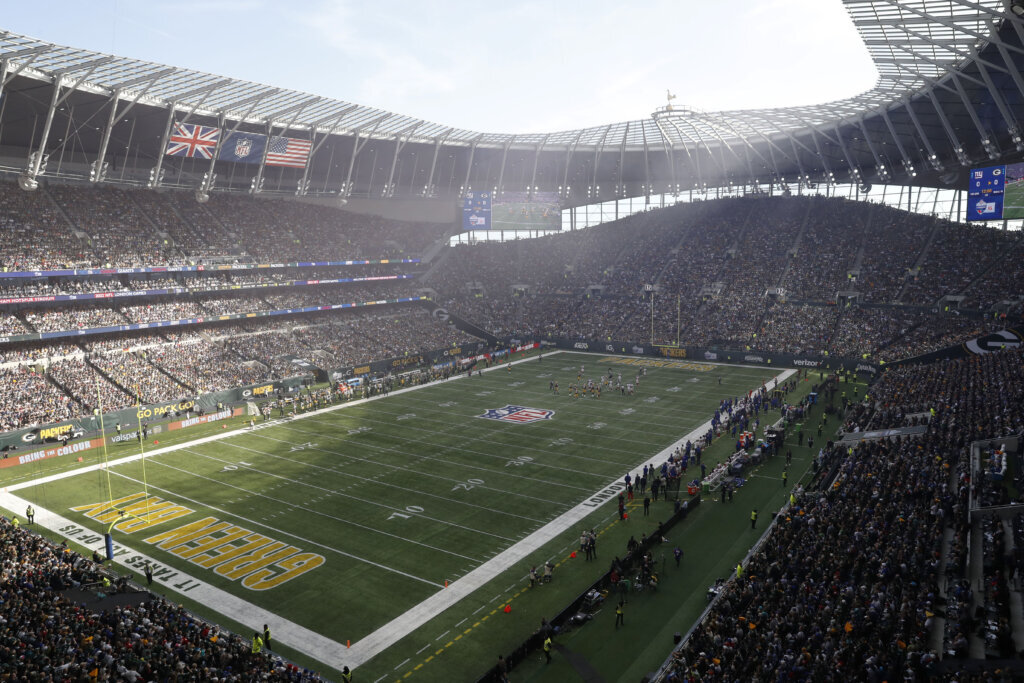
Hindsight may be 20-20 — or even 50-50, according to former Washington NFL coach Steve Spurrier. And while 20 years ago I don’t think we saw Sunday games at 9:30 a.m. on the landscape or playoff games on Nickelodeon (slime included), there will definitely be changes in the NFL over the next 10 to 20 years. Will we be surprised to see them?
Sometimes change is good, sometimes it’s simply change, and — more often than not with the NFL — change is what is used to make more money. And for every pipe-dream (I’m still waiting for the league to properly handle Thursday night by giving it to teams coming off bye weeks), there’s a development we hoped would come true (the two-point conversion).
What comes next in the league that’s 2023’s indisputable ruler of American sports?
Scheduling Up: Does anybody get psyched about the extra inter-conference game against a random team? I mean, instead of seeing the Washington Commanders play the Baltimore Ravens or the Jets meet the Giants every season.
With a handful of exceptions, most teams have a near-obvious regional partner (Detroit-Cleveland, Seattle-Denver) they can play on an annual basis, and when called for, twice. Better matchups that involve local foes are better for the fans and travel.
Laboring to Eighteen: The NFL had a 16-game schedule for over 40 years, before squeezing another week out of its players a few years ago. There’s no reason why, with another carrot thrown to players, they couldn’t add another to bring the total to 18.
They could tack the “annual interconference local game” to the current schedule and this would also allow the league to move back and forward.
Adding another bye (for health concerns) to push the regular season finish forward one more week in January to place the Super Bowl on Presidents Day weekend, while moving the regular season start back to Labor Day (as they did between 1978 and 2000). That’s 20 weeks of regular season broadcast revenue pouring in.
Expansion: The league has gone 20-plus years since adding the Houston Texans, the longest stretch of non-expansion in the history of the sport (the previous gap lasted between 1976 and 1994).
Current owners who expect hefty return on their investment — regardless of the current economic conditions — want more revenue and that will come in the form of expansion entry checks from new franchises.
Television networks and streaming sites want more commercial inventory and that means more than the 16 games per week. The NFL Players Association wants more jobs and the 50-plus more roster spots per team will convince it to overlook safety and other concerns.
So let’s add eight more teams to give each division five teams (not unheard of from 1970-2001):
East additions: London and Munich. The NFL has force-fed Europe down our throats for over a decade — long enough for roots to grow. This would also establish a permanent 9:30 a.m. broadcast window.
South: Orlando, Birmingham and San Antonio. If you can put a professional football team where soccer is king, why not where college football rules the roost?
Meanwhile, Indianapolis moves to the AFC North, where they’re a stone’s throw from Cincinnati and Cleveland — and where they belonged geographically a lot more than Baltimore (which is on the east coast).
And a Colts-Baltimore matchup twice a year would be fun. This also creates immediate in-state rivalries like Houston-San Antonio and Orlando-Tampa Bay, or Orlando-Miami if you want to move Jacksonville to the NFC. Or even a regional rivalry like San Antonio-New Orleans, because we know there’s no way Dallas is moving out of the gold mine of markets that is the NFC East.
North: St. Louis. An old-school NFL/NFC city as the Cardinals and then Rams’ home from 1960-87 and 1995-2015, the (insert new name here) will fit in well with a quartet whose average age is 88.
West: Portland and San Diego. This would give Seattle a travel partner in the Pacific Northwest and allow for a fan base to show up in force when the Chargers visit the city they left once a year.
The new schedule would have to be fixed a little, with teams playing eight division games (twice against each team) plus five against another division in the other conference. But I’m sure the NFL can generate a system where the other four (or five) games get distributed in a way where every team currently visits each other’s stadium over an 8-year period (minus international trips).
Live Begins at Twenty: Bear with me here. Eight division games, plus five inter-conference games against a division, plus five games against another in-conference division, plus two games against teams that finish in the same place (defending division champs play each other, etc.) equals a 20 game schedule.
For the record, the old World Football League in 1974 played a 20-game slate. Again, the NFL expanded from a dozen games in 1960 to 16 in 1978. So 20 isn’t that much of an increase.
Roster Revamping: Despite the players getting bigger and the regular season getting longer, the game day roster size has remained roughly the same since the 1970s, when it was bumped to 47 in 1974.
The current 53-man roster boasts eight inactive players each Sunday. Make them officially eligible to play. With a 17, 18 or 20-game schedule that involves at least one short week a year, I think a 60-man game day roster makes sense from a health and rest standpoint.
And on that roster, a team has to carry three full-time quarterbacks. No signing dudes off the street midseason when injuries hit (as they often do). Make the practice squad QB’s like Jake Fromm a part of the game day roster — as they’re doing the work anyway. Of course, this is a proposal that doesn’t pad the profit margin so the chances of this happening are slim.
Opening Windows: Forty teams mean 20 games. The additional commercial inventory (and European teams) means the 9:30 a.m. game is a regular thing — save the first and last Sunday.
While we’re at it, how about multiple Monday Night Football games, multiple times, during the season? That would allow ABC/ESPN to flex matchups to give their A broadcast crew and their audience as many non-clunkers as possible.
And on non-bye weeks, that means two games on Monday night, plus the 9:30 a.m. Sunday game in Europe. Even late-season Saturday tripleheaders once college football’s playoff moves past the first round.
Pumping up the Sweet Sixteen Playoff Party: Having 16 out of 40 teams in the postseason gives us two more games in the first round (it happened during the 1982 strike year), and one can have tripleheaders on Saturday and Sunday plus Friday and Monday night without missing a beat.
In a perfect world, the teams that play Friday will have had games on Saturday or early Sunday, but there are no guarantees.
Thinking Through Thursday: If we are going to have two byes in a 20-week season, let’s be smart with the Thursday night product.
Due to the complex nature of game plans and the physicality of this collision sport, going from Sunday to Thursday leaves teams overworked and underprepared with the added chance of a player banged up, unable to suit up in a game that might determine a team’s playoff path.
A bye week before the Thursday Night Football game would be safer for the players and more entertaining for consumers, allowing owners to charge more for the package.
Women’s Game: We already have women on coaching staffs around the league. Will we see a female coordinator anytime soon?
On the air, I see the revolution a lot sooner as women have been employed by all the broadcasters as sideline reporters for decades — and studio hosts more recently.
I see a female play-by-play broadcaster added to each primary network in the regular rotation sometime in the next five to 10 years. One who gets plenty of heat being a woman calling games, but manages to succeed long-term on the air.








